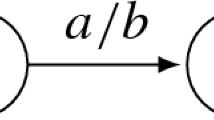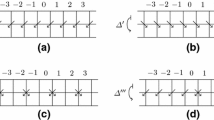Abstract
The properties of endomorphisms and automorphisms of a finite, deterministic automatonA related to the smallest input-independent partition on the set of internal states ofA are investigated. The setH d of all thed-endomorphisms ofA defined here, as well as the setG d of all thed-automorphisms ofA, are studied in detail. It is proved thatH d forms a polyadic semigroup, whileG d forms a polyadic group. Connections betweenG d and the groupG(A) of all the automorphisms ofA are examined. The upper bound for the cardinality ofG d is given.
Finally, by means of the theory ofd-automorphisms, some problems of the theory of strictly periodic automata are solved; in the first place, the necessary and sufficient condition for the reducibility of an arbitrary strictly periodic automation is given.
Similar content being viewed by others
References
R. Bayer, Automorphism groups and quotients of strongly connected automata and monadic algebras. Report 204, Department of Computer Sciences, University of Illinois, Urbana, May 1966.
R. Bayer, On the endomorphisms and congruences of automata. Mathematical Note 497, Math Res. Lab., Boeing Scientific Research Laboratories, Jan. 1967.
A. A. Buhštab,Number Theory (Russian), Izd. “Prosveščenie”, Moscow, 1966.
P. Deussen, Some results on the set of congruence relations in a finite, strongly connected automaton,Computing (Arch. Elecktron. Rechnen)2 (1967), 353–367.
G. Feichtinger, Some results on the relations between automata and their automorphism groups,Computing (Arch. Elektron. Rechnen)1 (1966), 327–340.
A. C. Fleck, Isomorphism groups of automata,J. Assoc. Comput. Mach. 9 (1962), 469–476.
A. Gill, Analysis of linear sequential circuits by confluence sets,IEEE Trans. Electronic Computers EC-13 (1964), 226–231.
A. Gill, Time-varying sequential machines,J. Franklin Inst. 276 (1963), 519–539.
A. Gill andJ. R. Flexer, Periodic decomposition of sequential machines,J. Assoc. Comput. Mach. 14 (1967), 666–676.
J. W. Grzymala-Busse, Automorphisms of polyadic automata,J. Assoc. Comput. Mach. 16 (1969), 208–219.
J. W. Grzymala-Busse, On the periodic representations and the reducibility of periodic automata,J. Assoc. Comput. Mach. 16 (1969), 432–441.
J. W. Grzymala-Busse, Periodic representations andT-partitionable equivalents of sequential machines. (Submitted for publication.)
J. Hartmanis, On the state assignment problem for sequential machines I,IRE Trans. Electronic Computers 10 (1961), 157–165.
J. Hartmanis, Maximal autonomous clocks of sequential machines,IRE Trans. Electronic Computers 11 (1962), 83–86.
J. Hartmanis andR. E. Stearns,Algebraic Structure Theory of Sequential Machines, Prentice-Hall, Englewood Cliffs, N.J., 1966.
E. L. Post, Polyadic groups,Trans. Amer. Math. Soc. 48 (1940), 208–350.
G. P. Weeg, The structure of an automaton and its operation-preserving transformation group,J. Assoc. Comput. Mach. 9 (1962), 345–349.
S. S. Yau, Autonomous clocks in sequential machines,IEEE Trans. Electronic Computers EC-14 (1965), 467–472.
Author information
Authors and Affiliations
Rights and permissions
About this article
Cite this article
Grzymala-Busse, J.W. On the endomorphisms of finite automata. Math. Systems Theory 4, 373–384 (1970). https://doi.org/10.1007/BF01704080
Received:
Issue Date:
DOI: https://doi.org/10.1007/BF01704080




